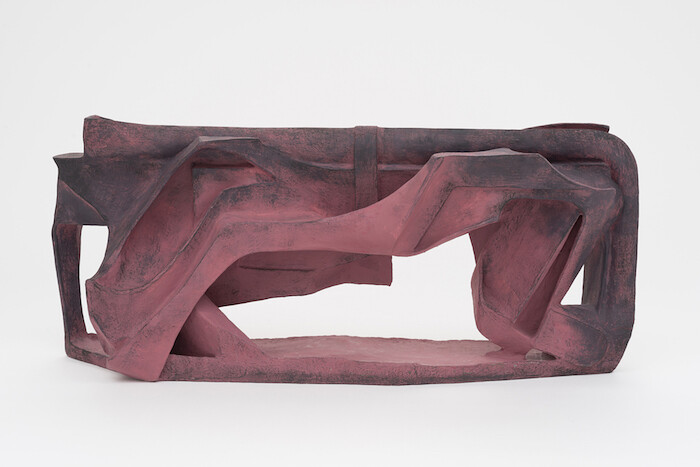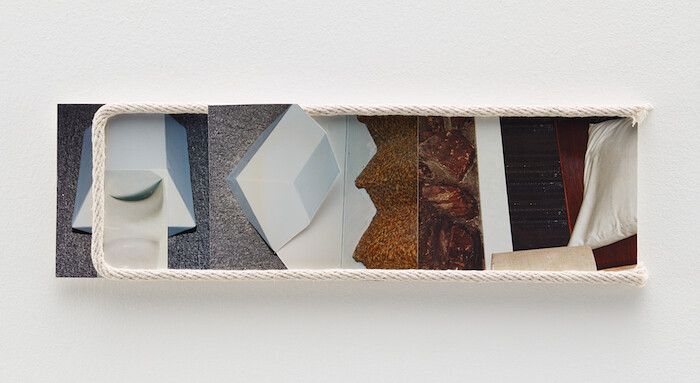Nature has a habit of reproducing its best engineering––why reinvent the circuitry of veins if you have their blueprints in the roots and branches of trees, in the shapes of rivers flowing from tributaries? Fractal patterns are iterated everywhere: in succulents, cauliflowers, snail shells. Vincent Fecteau’s sculptures, too, feel borrowed from natural forms such as grottoes and caves. In fact, there is something rather grotesque about them: organic nooks and stalactite-like shapes coalesce into liminal, terrestrial landscapes.
In the main room of Fecteau’s current solo exhibitions at Matthew Marks’s Los Angeles space, four sculptures sit on plinths ringed sparsely by four wall-mounted collages while a second, smaller gallery brings together a single sculpture with a single collage (all of the works are untitled). Collages previously shown in 2014 at Marks’s New York gallery are reunited with others from the same period, and brought together for the first time with sculptures made for an exhibition at Vienna’s Secession in 2016. The juxtaposition of pieces from different moments and contexts affords the viewer an opportunity to consider how Fecteau’s two dominant mediums––which can read as distinct conceptual and formal strands––have been in critical dialogue over the last several years.
In his 2014 exhibition at Marks, the sculptures were fixed to the wall and compactly built; the pieces shown here are comparatively Brobdingnagian: papier-mâché beasts of ambiguous origin (they’re a little larger than an average human torso) colored in slightly drab, mammalian shades. The effect is discomfiting. Forms contort in humanoid fashion, aortal protuberances connect to intestinal warrens, edges break at corners like elbows or knees. Yet the overall impression is as much mechanic as it is somatic. It’s easy to see echoes of the Futurists—car engines and front grills, auto body curves, fenders, exhaust pipes, even side-view mirrors—if you look for them, but his twisted, stalactitic forms always return to the realm of the organic. Caves are in-between spaces, neither earth nor sea, neither totally above nor below ground; yet they are also the sites of the first art attributable to humans. Fecteau’s quiet details—green and red gingham ribbon adhered to the edges of one dun-colored piece; a serpentine length of rope; a cardboard tube from an exhausted roll of paper towel; a fine mist of contrasting pigment––feel more like testaments to existence than decorative or compositional gestures.
A more apt comparison than the bellicose Futurists is their contemporary, Kurt Schwitters (1887–1948). Schwitters, like Fecteau, was a consummate collagist, but the more salient parallel lies in Schwitters’s architectural installations, which he adapted and added to compulsively. Schwitters created his Merzbau (“merz” being the nonsense word he assigned to his craft) in his Hanover residence between 1923 and 1937. He undertook a second version—the Merz Barn—in 1947 in rural isolation: a sort of bas-relief mural spanning the wall of a small stone barn in the English Lake District. The formal consonances between Schwitters’s Merz Barn and Fecteau’s discrete sculptures are difficult to ignore—flairs of colored paint to highlight certain features; inscrutable molded shapes; unexpected S-turns intent on ushering us into the fourth dimension.
Fecteau builds each new work around a different found object. Indeed, finding something—be it an entire stone wall or a snippet of ribbon—is the magpie-like compulsion that undergirds his and Schwitters’s practices. Both artists depend on the found environment, fugitive or fixed, to be the creative cipher. Fecteau’s collages bear little formal resemblance to his sculptures, but they are similarly reliant on the identification of a preexistent, catalytic object or image. In either medium, the ordinariness of the found element is typically eliminated or distorted through a process that is as much a practice of erasure as one of addition. Though made off existent things—a box for shipping cut flowers, say (Fecteau worked for a time as a florist), or a magazine advert—a finished work will, more often than not, belie its origins. There is something incredibly tactile and intimate about these works—the nubby, stucco-like texture of his papier-mâché sculptures; the hand-cut photos rimmed imperfectly in slender rope—but a feeling of obfuscation nonetheless prevails. Nowhere is this contradiction more felt than in the collages.
The exquisite, almost lapidary mixed-media collages in the current show are embellished with three-dimensional jetsam—a popsicle stick; a grosgrain ribbon; a bit of rope; wire mesh to prop the curling corner of an image—and, as such, bridge the gap between his two chosen mediums. Three-dimensionality, the feeling of there being faces and backs to Fecteau’s works (which is which is often intentionally unclear), is critical to a practice that depends on the queering of hard-edge and binary forms. This impulse was taken to an extreme in the publication for his 2016 Secession exhibition. Not only were the illustrated works absent from the exhibition—they had never existed, at least not beyond the constraints of a Photoshop file. The book was laid out so that the “back” of each collage was printed on the verso of the page illustrating its “face,” resulting in the attribution of physicality to something absent a body. The current exhibition allows the viewer to observe a group of works that likewise speak to Fecteau’s flirtation with the sublimation of form. From some angles, the sculptures in this impressive show recall chrysalises. In the time it takes to traverse the gallery, the viewer half-expects to discover that one of them has broken free of its carapace, shape-shifted, become something else altogether.









